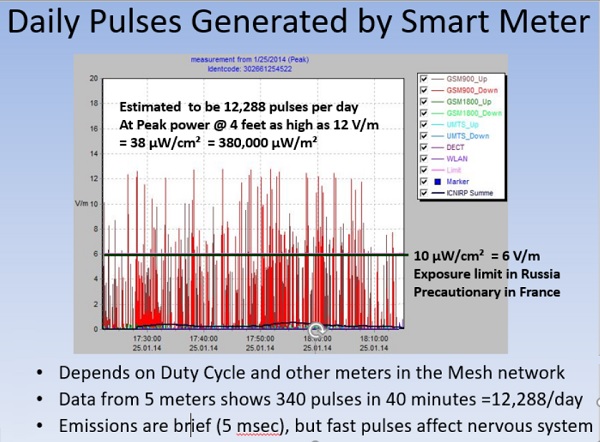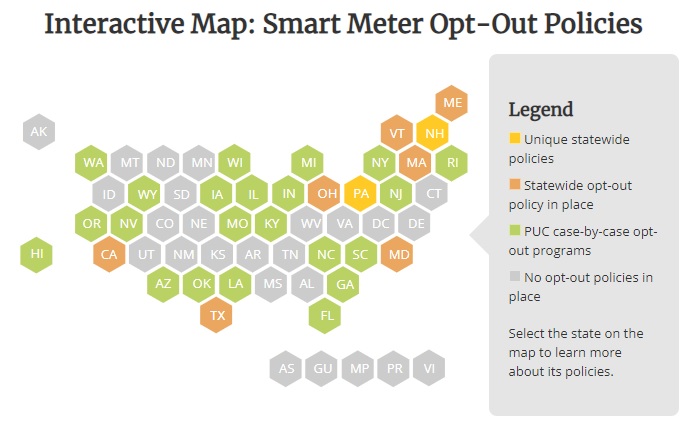The push by local governments to install Smart Meters within their respective residential communities will see a 75% adoption rate in the US by the end of 2021, representing approximately 115 million installations. Given the rapid and pervasive adoption of these devices, we provide a comprehensive overview of:
- Why these meters are being pushed so aggressively
- What homeowners should know about them, and
- How homeowners can effectively deal with them
The goal of this article is to provide information that helps homeowners become more aware of the issues surrounding Smart Meters, especially health concerns, and to present viable options on how best to deal with smart meters for their given situations.
Table of Contents
- What are Smart Meters?
- What is the Purpose of Smart Meters?
- The Stated Benefits of Smart Meters
- Disadvantages of Smart Meters to Consumers
- Smart Meter Health Concerns
- Options If You Already Have a Smart Meter
- How to Opt Out of a Smart Meter Program
- Smart Meter Consumer Resources
What are Smart Meters?
Smart Meters are electronic devices that record and transmit utility consumption information for electricity, water and gas from a residential unit to a central system. The meters communicate information, such as voltage levels, current, water flow, and gas flow, to the utility provider and ultimately to the customer for system monitoring and billing.
Smart meters communicate via a secure national network that that emit a burst of Radio Frequency radiation in short intervals throughout the day to allow real-time energy readings and utility monitoring. The average smart meter has a frequency of operation in the 902 MHz and 2.4 GHz bands.
The Purpose of Smart Meters
The published intent of these devices is to improve service by accessing and analyzing customer usage, while decreasing the providers’ operational costs. A common benefit cited is the ability to detect critical performance issues in real-time, such as water and gas leaks.
What are the Benefits of Smart Meters?
Proponents of smart meters have pushed their roll-out and widespread usage on the basis of the following perceived benefits:
- Clarity of Consumption Behavior
- Early Notification of System Malfunctions
- Lower Labor & Maintenance Costs
- Accurate Billing
- Improved Operational Cost
Clarity of Consumption Behavior
Utility customers are able to view and manage their personal energy consumption in real-time. The thought here is that customers will adjust their behaviors, as they monitor their own daily usage. Consumers that stay on top of their usage metrics are also more likely to reduce consumption levels, detect leaks, or discover unauthorized usage, such as third-parties tapping into your external water or electricity sources.
Early Notification of System Malfunctions
More than twenty years ago, utility companies relied upon calls from customers to alert them to any malfunctions in their systems, such as power outages, water main breaks or gas leaks. Smart meters allow for automated detection of anomalies based on acoustics for water and gas, and unusual or higher than average consumption data for energy.
The meters allow for more granular information that help utility companies identify and respond to service defects and other issues in a more cost-effective manner by pinpointing outages and the exact customers affected.
Lower Labor & Maintenance Costs
Since smart meters constantly relay information to the supplier, there is no longer a need for a human meter reader, an outdated and inefficient method of days gone by. The technology is referred to as Advanced Metering Infrastructure (AMI) and can read entire cities at one time, versus the geographically constrained human meter reader, who was required to walk house-to-house reading each home’s meter.
Accurate Billing
With AMI, customers are promised more accurate readings, and can monitor their own consumption with their own devices and an internet connection. Based on personal experience, we recommend not being lulled into assuming that these measurement systems are always error-free. Be sure to always follow-up when detecting any discrepancies in either usage measurements or billing amounts.
Improved Operational Cost
With the potential of AMI, utility companies are promising they can do more with less manpower, which should translate to improved operational costs and lower utility bills for customers. The less staff-intensive systems are often cited as a benefit to customers, since automation has replaced manual processes, such as the need for meter readers, customer service representatives, and other operational overhead.
Disadvantages of Smart Meters
A number of disadvantages have been the subject of countless articles and academic papers over the years, as Smart Meter proliferation around the globe takes hold, without ample requisite studies and investigations on the potential harm to human health and other societal issues, such as privacy.
Based on our findings, at a minimum, utility companies and local municipalities have done a poor job communicating and justifying the need for smart meters, and offering viable options for customers that wish to not opt-into their programs.
- Privacy Concerns
- Meter Dangers for Fire Risks
- Questionable Accuracy
- Throttling Concerns
- Health Concerns
Privacy Concerns
With any data driven internet-enabled systems, there is always the risk of a system being compromised, and thus privacy being breached. Information such as credit cards (if you pay using cards) bank accounts and social security information are all captured in the system and are vulnerable to the most basic security hack.
The fact that smart meters can intelligently determine the usage of specific devices and products (e.g. appliances; hair dryers; computer devices; television/video devices; etc.) provides another nefarious opportunity for corporate marketers to connect the following consumer behavior and data:
- WHAT you buy (Online Purchases & In-Store Barcodes)
- WHO bought it (Online Accounts & Loyalty Programs)
- And now: WHEN, WHERE and HOW products are consumed (Smart Meter tracking)
Meter Dangers for Fire Risks
Smart Meters have been known to malfunction and cause fires due to meter design and function. Surges and overvoltage in electric meters can burn wiring and destroy appliances and other electronics. In fact, fires caused by smart meters have become such a concern that, in tandem with utility companies not being forthright with insurance carriers, the insurance underwriter industry has explored not providing coverage for home fires caused by smart meters.
Questionable Accuracy
Customers have complained that smart meters are not necessarily that accurate, leading to higher than average utility bills. Consumers are also concerned about the threat of higher “time-of-usage” charging that could lead to more costly bills, which would negatively impact their normal usage behavior.
Throttling Concerns
Details on your private energy consumption, in theory, can be connected with other data sources to empower local governmental entities to wield undue influence on your utility usage. For example, could local municipalities adjust usage settings for residents that owe past-due parking meter fines? Could usage limits be imposed on households based on arbitrary criteria, such as square footage, number of residents, size of lot, time of day, day of week, etc.?
Health Concerns Pertaining to Smart Meters
Opponents of Smart Meters are concerned about the health risks that are becoming evident with the large amount of Radio Frequency (RF) Radiation exposure that is emitted from the devices on a frequent basis.
Empirical findings have documented the following symptoms of people claiming to have had health ailments directly or indirectly affected by EMF radiation emitted by smart meters:
- Sleep Disturbances/Insomnia
- Headaches
- Nausea
- Body Aches
- Ringing or buzzing in the ears (Tinnitus)
- Fatigue
- Loss of concentration, memory, or learning ability
- Disorientation, dizziness, or loss of balance
Smart Meters emit RF-EMF radiation, which has been classified by the World Health Organization (WHO) as a Group 2B carcinogen (a possible human carcinhogen). To put this classification in perspective here are other examples of 2B carcinogens: Arsenic; Asbestos; Formaldehyde; and Lead.
Interestingly, the American Cancer Society’s official statement on RF radiation repeats the “possibly carcinogenic” premise, but does not address the strength, frequency of RF bursts, nor the proximity of devices, such as smart meters to residents when mounted on residential buildings.

Image courtesy of Dr. David O. Carpenter, MD.
In 2011, 30 scientists from 14 countries assessed the carcinogenicity of electromagnetic fields (RF-EMF), the results of which were published in the International Agency for Research on Cancer (IARC) Monographs. A summary of the findings reveal that human exposure to RF-EMF in the frequency range of 30 kHz to 300 GHz can occur from various household sources, such as mobile telephones, Bluetooth devices, smart meters, and other personal devices. These currents permeate into the body’s tissues and is associated with physical and emotional harm, including potential carcinogenic effects.
Although this study focused mainly on cell phones and other personal devices, the research was focused on high-frequency and high-powered pulsed radar, similar to those associated with smart meters. Their emission of radiofrequency radiation, which is a by-product of radiofrequency waves, is a fact and thus there is no data supporting the claim that RF radiation is safe.
Despite the US safety limit for RF radiation being 1,000 micro-watts per square meter, the average smart meter emits up to 60,000 micro-watts per square meter of RF radiation at 30-45 second intervals. The interval frequency may vary depending on the utility set up. The frequency of these bursts can significantly increase if smart meters need to relay communication signals through neighboring smart meters in order to reach a nearby cell tower (using a smart grid AMI MESH network).
Dr. Anne Meyers
A vocal opponent of smart meters has been Dr. Anne Meyers, a practicing functional medical physician, who frequently treats patients with autoimmune, thyroid and other conditions that she attributes to “electropollution“. Dr. Meyers has been a relentless advocate of removing Smart Meters from residential buildings and detoxifying the body of harmful pollutants caused by RF-EMF radiation exposure.
According to Dr. Meyers’ website, electropollution from smart meters triggers an immune system response due to the electrical fields in the body being “misinterpreted as foreign invaders”. The results of this are chronic inflammation, cognitive problems, brain fog, anxiety, memory loss and fatigue.
Dr. Samuel Milham
Dr. Samuel Milham, a noted physician and epidemiologist, specializing in occupational medicine and the health effects of electromagnetic fields (EMF), has been extremely vocal on the subject of RF-EMF dangers. In a critique of a report by the CCST, California Council on Science and Technology, he admonished the nonprofit organization for not alerting the public on smart meter dangers. He stated:
“Your report, unfortunately, reads as if were written by PG&E or Edison, and pays no attention at all to a very important EMF exposure variable, dirty electricity (high frequency voltage transients and harmonics).”
He is best known as the scientist who first alerted the world about the causative link between exposure to electromagnetic fields, electromagnetic pollution, and human disease.
As the author of a powerful study on “dirty electricity” and cancer, Dr. Milham explains the chain of causation and how the use of such devices can lead to chronic health conditions. With 30 plus years of research on the subject, Milham has concluded that the emission of electrical energy from devices that create voltage surges lead to unhealthy levels of intracellular calcium ions, which can prove toxic. He further states that a rise in calcium ions triggers a rise in nitric oxide, which is a precursor to peroxynitrite.
Peroxynitrite can create free radicals, damage proteins and lipids, and cause damage to the blood brain barrier and stomach lining. The result of these changes are impaired neurological function, organ dysfunction and fatigue.
In his popular book, Dirty Electricity: Electrification and the Diseases of Civilization, Milham is critical of smart meters. In public testimony he has stated: “it is my professional opinion that smart meters are a public health hazard.”
Milham links dirty electricity to cancer, heart disease, diabetes, Alzheimer’s, and suicide. He also connects it with neurological disorders such as multiple sclerosis and Lou Gehrig’s disease.
We have scoured academic and scientific journal to find a human clinical study assessing the health effects from RF exposure from smart meters. However, as of this publication date, none exists. How can anyone assess the safety of smart meters, if no human studies have been conducted?
Options If You Already Have a Smart Meter
If you are confined to living with a smart meter and are concerned about its impact on your family’s health, here are various products that can help mitigate the emission of RF-EMF radiation.
Products to Manage RF-EMF Radiation Emissions
Customers concerned with emissions of RF radiation can retrofit their Smart Meters with a shield or cover. There are a number of products available for the deflection of RF-EMF radiation emission, which typically are similar to a Faraday cage that is used in microwave ovens, and promises to block over 98% of RF radiation emissions from smart meters.
- Smart Meter Covers & Shields
- Faraday Fabrics
- EMF Protection Paint
- RF-EMF Meters
- Analog Electric Meters
Smart Meter Covers & Shields
Faraday Fabrics
- Light Lounge EMF Protection Products
- Silent Pocket DIY Faraday Protection Fabric
- JJ CARE Faraday Fabric
- The Faraday Beanie
EMF Protection Paint
- Y-Shield RF Shielding Paint (1 Liter)
- ECOs EMR/EMF Shielding Paint
- Woremor RF-IE50 EMR & RF Shielding Paint (5 Liter)
RF-EMF Meters
Analog Electric Meters
- Refurbished Analog Electric Meters by ElectraHealth
- Be sure to read the helpful comments and resource links provided on this product page.
How to Opt Out of a Smart Meter Program
Many states offer their utility customers the option to “opt out” of the Smart Meter program by charging them a setup fee and a recurring charge each billing period. According to the NCSL, there are currently only two states – New Hampshire and Vermont – that allow customers to decline smart meters at no cost.
Typically this “opt out” option will NOT prevent your utility company from installing a smart meter, it will merely prevent them from turning the radio in the “ON” position. With the radio in the “OFF” position, there is a decreased danger of RF of frequent radiation emissions from the device.
To familiarize yourself with this process, here are two example opt-out programs offered by two utility services in California:
Another option to consider pursuing is to have an analog meter installed by your utility company as a Disabled Accommodation request, providing that you legitimately suffer from electromagnetic sensitivity. Whether Electromagnetic Sensitivity is classified as a disability in the ADA (Americans with Disabilities Act) is still under debate, however. The Center for Electrosmog Prevention (CEP) provides guidance on how to write an accommodation letter pertaining to RF radiation and smart meters.
To check current smart meter opt-out policies, we recommend visiting the following resources:
- Opt-Out Programs in the US & Canada as of July 30, 2021 by the Coaltion to Stop Smart Meters in BC
- NCSL National Smart Meter Opt-Out Map

Image courtesy of NCSL.
Smart Meter Consumer Resources
Smart Attack! – A Satirical Video on Smart Meters
Take Back Your Power: A Smart Meter Documentary
Why We Fight – Naperville Smart Meter Awareness
- Health Risks Posed by Smart Meters
- Inside the Fight Between a Small Iowa Town and a $12B Utility Over Smart Meters
- Coalition to Stop Smart Meters in BC
- California Power Shut-Offs Pose Fire Risk Due to Smart Meters
- Manufacturer Defends Smart Meters after Fire
- Smart Meter Fires – IEEE Spectrum
- Smart Meter Fires and Explosions – EMF Safety Network
- Smart Meter Education Facebook Group
- Smart Meter Education Network
- Stop Smart Meters!
- Worldwide Smart Meter Resources & Activist Groups by Stop Smart Meters in BC
- How to Protect Your Home from Smart Meters
Related Articles
- The Impact of ADUS’s on Your Neighborhood: Perceptions vs. Reality
- UV-C Products to Make Your Home Healthier & Virus Free
- Need Help Falling Asleep? Give These Sleep Tech Products a Try!
| Purgula is reader-supported. When you click on links to other sites from our website, we may earn affiliate commissions, at no cost to you. If you find our content to be helpful, this is an easy way for you to support our mission. Thanks! Learn more. |







